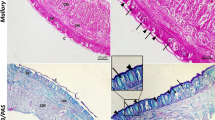Summary
The haemal and coelomic circulatory systems in arms and pinnules of a stalkless crinoid are described by transmission electron microscopy, and the coelomic topography is revealed by scanning electron microscopy of corrosion casts and peritoneal surfaces. In addition, the route of the coelomic circulation in the living crinoid is shown by injection of carmine particles, and sites of peritoneal phagocytosis are demonstrated by injection of latex beads. The most important morphological findings are: the controversial hyponeural circulation is haemal and not coelomic; peritoneal ciliation is general and not limited to the cells of the ciliated pits; and occur smooth muscle cells occur below the peritoneum. Carmine particles injected into the central body coelom rapidly travel outward toward the arm and pinnule tips via the aboral canals; the particles return to the central body via the subtentacular canals. Latex beads injected intracoelomically are taken up by peritoneal cells throughout the subtentacular, genital and aboral canals. The possible functions of the haemal and coelomic circulatory systems of crinoids are discussed.
Similar content being viewed by others
References
Baccetti, B., Rosati, F.: On the thick filaments of holothurian muscles. J. Microscopie7, 455–458 (1968)
Breimer, A.: General morphology, recent crinoids. In: Treatise on Invertebrate Paleontology, Part T, Echinodermata 2, Vol 1 (R.C. Moore, C. Teichert, eds.), pp. 9–58. Boulder, Colorado: Geol. Soc. Amer. 1978
Carpenter, W.B.: On the structure, physiology, and development ofAntedon (Comatula, Lamk.)rosaceus. Proc. Roy. Soc. London24, 211–231 +plates viii–ix (1876)
Clark, A.H.: Descriptions of new species of recent unstalked crinoids from the North Pacific Ocean. Proc. U.S. Natl. Mus.33, 69–84 (1907)
Cuénot, L.: Anatomie, éthologie et systématique des échinodermes. In: Traité de Zoologie, Vol. XI (P.P. Grassé, ed.), pp. 3–363. Paris: Masson 1948
Davis, H.S.: The gonad walls of Echinodermata: a comparative study based on electron microscopy, pp. 90. Master's Thesis, Univ. Calif, at San Diego 1971
Fenner, D.H.: The respiratory adaptations of the podia and ampullae of echinoids (Echinodermata). Biol. Bull.145, 323–339 (1973)
Ferguson, J.C.: An autoradiographic study of the translocation and utilization of amino acids by starfish. Biol. Bull.138, 14–25 (1970)
Hamann, O.: Anatomie der Ophiuren und Crinoiden. Jenaische Z. Naturwiss.23, 233–388 +plates xii–xxiii (1889)
Holland, N.D.: The fine structure of the ovary of the feather starNemaster rubiginosa (Echinodermata: Crinoidea). Tissue and Cell3, 161–175 (1971)
Holland, N.D., Jespersen, Å.: The fine structure of the fertilization membrane of the feather starComanthus japonica (Echinodermata: Crinoidea). Tissue and Cell5, 209–214 (1973)
Hyman, L.H.: The Invertebrates, Vol. IV, Echinodermata, pp. 763. New York: McGraw-Hill 1955
Lametschwandtner, A., Simonsberger, P., Adam, H.: Scanning electron microscopical studies of corrosion casts. The vascularization of the paraventricular organ (Organon vasculosum hypothalami) of the toadBufo bufo (L.). Mikroskopie32, 195–202 (1976)
Ludwig, H.: Beiträge zur Anatomie der Crinoideen. Z. wiss. Zool.28, 255–353 +plates xii–xix (1877)
Nichols, D.: The histology and activities of the tube-feet ofAntedon bifida. Quart. J. Microscop. Sci.101, 105–117 (1960)
Nichols, D.: The water-vascular system in living and fossil echinoderms. Palaeontology15, 519–538 (1972)
Nørrevang, A., Wingstrand, K.G.: On the occurrence and structure of choanocyte-like cells in some echinoderms. Acta. Zool. (Stockh.)51, 249–270 (1970)
Obinata, T., Ikeda, M., Hyashi, T.: Native thin filaments of sea urchin muscle. Fed. Proc.30, 492 Abs. (1971)
Teuscher, R.: Beiträge zur Anatomie der Echinodermen. I.Comatula mediterranea. II. Ophiuridae. Jenaische Z. Naturwiss.10, 243–280 +plates vii–viii (1876)
Vanden-Bossche, J.P., Jangoux, M.: Epithelial origin of starfish coelomocytes. Nature, London261, 227–228 (1976)
Author information
Authors and Affiliations
Rights and permissions
About this article
Cite this article
Grimmer, J.C., Holland, N.D. Haemal and coelomic circulatory systems in the arms and pinnules ofFlorometra serratissima (Echinodermata: Crinoidea). Zoomorphologie 94, 93–109 (1979). https://doi.org/10.1007/BF00994059
Received:
Issue Date:
DOI: https://doi.org/10.1007/BF00994059




